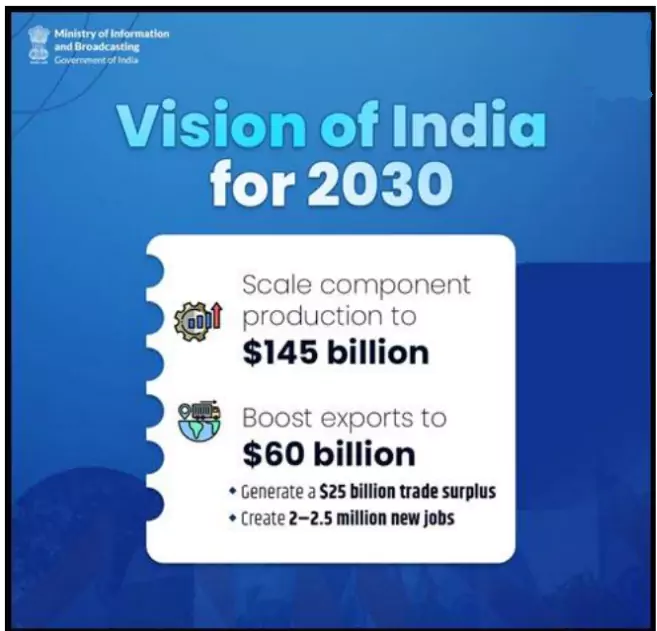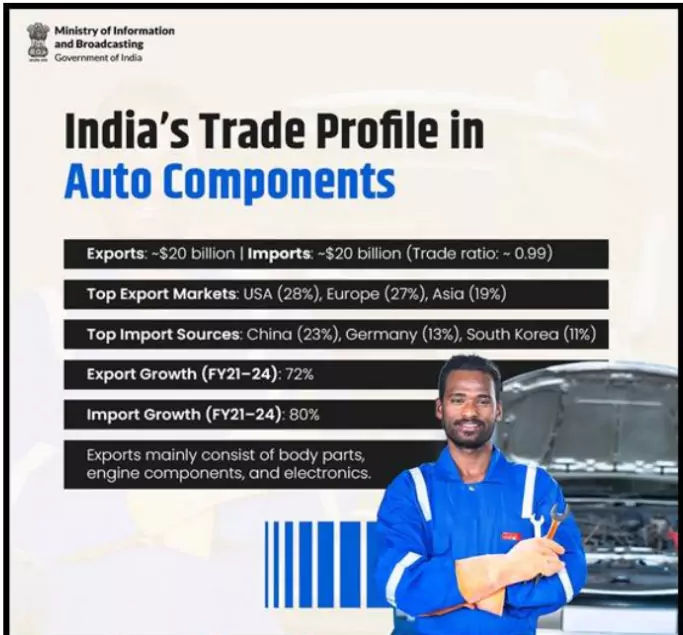At the International Value Summit 2025, the Union Minister for Road Transport and Highways stated that India is the third-largest automobile market, aiming for No. 1 globally in five years.
- In 2025, India surpassed Japan to emerge as the world’s 3rd largest automobile market, after China and the United States.
Key Data & Facts

- Global Contribution: India’s automotive sector contributes 7.1% to global GDP.
- Market Size: The Indian automobile sector, including vehicles and auto components, is valued at nearly ₹22 lakh crore, making it one of the largest industries in the economy.
- Passenger Vehicle Sales (2023): India sold 4.11 million units, overtaking Japan’s ~4 million sales, marking a major shift in global rankings.
- Exports Performance: In FY24, India exported 6.62 million vehicles, making it a global hub for two-wheelers and small cars.
- Two-Wheeler Dominance: More than 50% of India’s two-wheeler production is exported, reflecting India’s global competitiveness and cost advantage in this segment.
- Auto Components: With a turnover of ₹6.14 lakh crore ($74.1 billion) in FY24, the auto component sector contributes 2.3% to GDP, with exports worth $21.2 billion, projected to reach $30 billion by 2026.
- EV Penetration: By August 2024, 4.4 million EVs were registered, accounting for 6.6% penetration, signalling the beginning of India’s green mobility revolution.
- Future Scope: With targeted reforms and stronger GVC integration, India aims to raise its global auto component trade share from 3% to 8% by 2030.
Drivers of Automobile Growth in India

- Rising Global Presence: All major automobile brands are now manufacturing in India, from Maruti-Suzuki and Hyundai to Toyota, Tesla, and Mercedes.
-
- The trend has shifted from assembling vehicles for local markets to exporting Indian-manufactured cars worldwide, especially to Africa, Latin America, and South Asia.
- Clean & Green Mobility Push: Electric Vehicles (EVs) are supported under FAME II (Faster Adoption and Manufacturing of Electric Vehicles) and PLI schemes, India is building an EV ecosystem.
- Hydrogen Mobility: Launch of hydrogen trucks, with pilot projects running on 10 key transport routes, signals a futuristic shift.
- Alternative Fuels: Trials underway on isobutanol, bio-bitumen, and ethanol blends, aimed at reducing oil imports.
- Expanding Road Infrastructure: India now has the second-largest road network in the world, after the United States.
- Other Growth Drivers: A large domestic market, cost competitiveness, skilled workforce, and strong policy push (FAME, PM E-Drive, PLI, GST, scrappage) collectively position India as a rising global hub for automobile production, exports, and EV innovation.
Key Government Initiatives Driving Growth
- FAME-II Scheme (Faster Adoption and Manufacturing of Electric Vehicles): Incentivized over 16.15 lakh EVs and sanctioned 10,985 charging stations, boosting EV adoption.
- Production Linked Incentive (PLI) – Auto & Components: With an outlay of ₹25,938 crore, promotes Advanced Automotive Technologies (AAT) including EVs, hydrogen fuel cells, and auto components.
- PLI – ACC (Advanced Chemistry Cell Battery): Targets creation of a 50 GWh battery ecosystem, with 40 GWh capacity allocated to four firms, supporting EV and storage growth.
- PM e-Bus Sewa (2024–29): Aims to deploy 38,000+ electric buses, strengthening clean public transport.
- Policy Measures:
- GST on EVs reduced from 12% to 5%.
- Model Building Bye-Laws, 2016 amended to mandate EV charging stations in residential and commercial complexes.
- Vehicle Scrappage Policy (2021): Encourages phasing out vehicles >15 years, reducing emissions and stimulating demand for new vehicles.
|
Read More About: NITI Aayog Report: EV In India
![]() 17 Sep 2025
17 Sep 2025



